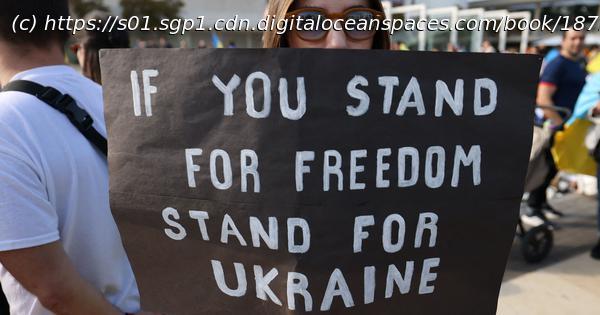The best form of support for us here in India is to make the effort to prepare basic information and analysis to counter Moscow’s propaganda about the conflict.
Ukraine has resisted the Putin invasion for a full year. A year full of mass killings, mass deportations, the separation of Ukrainian children from their parents, accompanied by incessant genocidal hate speech on Russian TV.
Last year, on the very day of the invasion, the Hindu Sena – which known for cutting a cake on Trump’s birthday – put up posters at the statue of Russian writer Alexander Pushkin at Mandi House in Delhi, that read “Indian Hindus are with Putin and Russia in re-establishing the Soviet Union. Jai ho Akhand Russia. Jai Bharat.” The phrase “Akhand (Unbroken) Russia” is a deliberate comparison of Putin’s imperialist invasion to the Hindu supremacist agenda of “re-establishing” an Akhand Bharat – a Hindu “Unbroken India”.
Hindu supremacists claim that Afghanistan, Pakistan, Bangladesh, Sri Lanka, Myanmar, Maldives, Tibet, Bhutan, Nepal and Aksai Chin as well as India are a single entity: an inseparable “geo-cultural” and “spiritual” entity , “a civilisation and cultural oneness that politics dismembered”.
The Hindu Sena is not being ridiculous. If Russian President Vladimir Putin is not defeated decisively, if his invasion yields in anything but a decisive defeat; if it yields even the most nominal payoff – another chunk of Ukrainian territory, perhaps, or restrictions on Ukraine’s independent foreign policy – fascist and despotic bullies everywhere will be emboldened and incentivised to pursue their own imperial and genocidal projects, assured that invasions yield a domestic as well as geopolitical payoffs.
In May 2022, writer-journalist Sushant Singh who is a keen observer of foreign policy and geopolitics, warned, “The world ignored Russia’s delusions. It shouldn’t make the same mistake with India.” He identified the common thread between Putin’s denial of Ukraine’s existence as a state to restore Russia’s perceived historical greatness, China’s claim to “historical territory” to overcome its so-called century of humiliation, and the claim manufactured by the Rashtriya Swayamsevak Sangh and Narendra Modi to restore unbroken Hindu civilisation.
As Singh puts it, “Leaders have long relied on manufactured history to justify invasions.”We should not be surprised if Indian fascists whose shadowy functionaries operate with total lack of transparency and accountability, are watching Russia’s fate closely – and are calculating possible moves in the direction of ‘Akhand Bharat’.”
Putin’s invasion is based on the claim which he has repeated years before 2022 – that Ukraine does not exist as a nation. In the name of “de-Satanisation”, those who persist in identifying as Ukrainian must be wiped out. This ought to have been blindingly obvious to anti-fascist Indians (the Indan fascists saw this very clearly). The fascist Akhand Bharat agenda too is based on a denial of the nationhood of the countries named above, and also a demand that Indian Muslims must “assimilated into Indian nationalism which is Hindu nationalism, and Indian culture which is Hindu culture”or else be “driven out”.
In October 2022, Rashtriya Swayamsevak Sangh chief Mohan Bhagwat announced that Akhand Bharat would become a reality in 10 years-15 years. “Hamari gaadi chal padi hai, bina brake ki gaadi hai, sirf accelerator hai,” he declared. “Jo rokne ki koshish karenge, woh mit jayenge. Jo aana chahe, woh hamare saath aa ke baith jaaye, gaadi rukegi nahi.” Our car is on its way. It has no brakes, only an accelerator. Anyone who comes in the way will be destroyed. Those who want can come join us in the car. This car won’t stop.
The “car without brakes that crushed anyone in the way” is a well-chosen metaphor: for most Indians, this would bring to mind Narendra Modi’s words in an interview with Reuters during his campaign as a prime ministerial candidate. Asked if he regretted the anti-Muslim massacres that took place on his watch as Gujarat chief minister in 2002, he replied, “If someone else is driving a car and we’re sitting behind, even then if a puppy comes under the wheel, will it be painful or not? Of course it is.”
Those resisting the “accelerating car” of Hindu supremacism in India, any Indian concerned with democracy and experts who comment on geopolitics ought to be able to see that Putin, just as much as Donald Trump in the US, shares a political and ideological project with Modi, and with despots like China’s Xi Jinping. It is interesting then to note that Indian civil society as well media and social media is saturated with Putin propaganda on Ukraine. The vast ecosystem that believes and reproduces whichever element of Putinist propaganda confirms their particular biases includes leading journalists, foreign policy commentators and strategists, former Indian diplomats and retired military officers, as well as progressive and left activists and organisations.
For instance, on February 22, two days before the anniversary of Russia’s invasion of Ukraine, N Ram, one of India’s most respected journalists, who is also known to be left-leaning, attended a photo exhibition titled “Ordinary Nazism” at the Russian Centre of Science and Culture in Chennai where he was hosted by the Consul General of Russia. Addressing a talk on the “Genesis of Ukraine-Russia conflict”, Ram said praised the USSR and then Russia for being “an all-weather friend” of India.
His next observation was most extraordinary. N Ram, who is known for his sharp criticisms of Hindu supremacist policies and the “Hindu Nation” project, said that the “conflict” between Russia and Ukraine “goes back to the history of the Russian Orthodox Church”, and that “every attempt is made by the Zelensky regime, with the support of the most reactionary forces in the world, to eradicate those historical ties is impossible”.
Home
United States
USA — mix Kavita Krishnan: One year after the Russian invasion, what should solidarity with...






